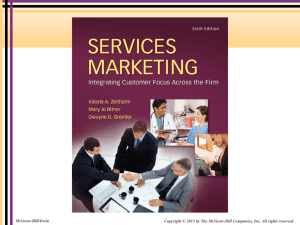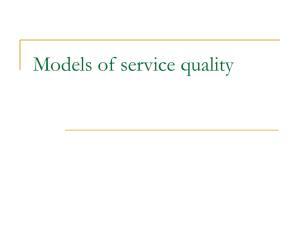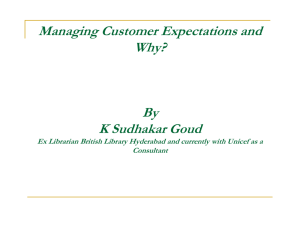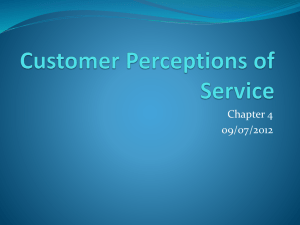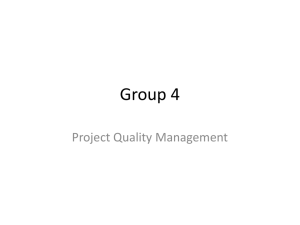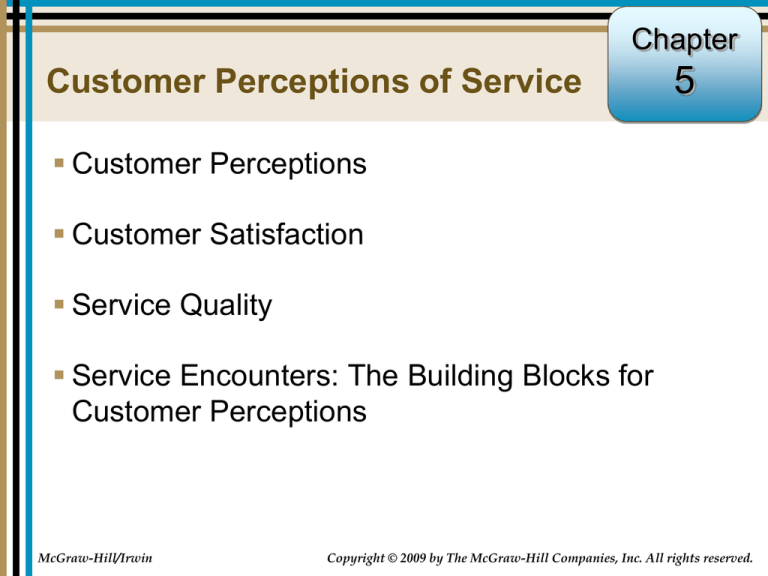
Chapter5-1
Customer Perceptions of Service
5
Customer Perceptions
Customer Satisfaction
Service Quality
Service Encounters: The Building Blocks for
Customer Perceptions
McGraw-Hill/Irwin
Copyright © 2009 by The McGraw-Hill Companies, Inc. All rights reserved.
Objectives for Chapter 5:
Consumer Perceptions of Service
5-2
Provide a solid basis for understanding what influences
customer perceptions of service and the relationships among
customer satisfaction, service quality, and individual service
encounters.
Demonstrate the importance of customer satisfaction—what it is,
the factors that influence it, and the significant outcomes
resulting from it.
Develop critical knowledge of service quality and its five key
dimensions: reliability, responsiveness, empathy, assurance,
and tangibles.
Show that service encounters or the “moments of truth” are the
essential building blocks from which customers form their
perceptions.
5-3
The customer is . . .
Anyone who receives the company’s
services, including:
external customers (outside the organization,
business customers, suppliers, partners, end
consumers)
internal customers (inside the organization, e.g.,
other departments, fellow employees)
Customer Perceptions of Quality and
Customer Satisfaction
5-4
Factors Influencing Customer
Satisfaction
5-5
Product quality
Service quality
Price
Specific product or service features
Consumer emotions
Attributions for service success or failure
Perceptions of equity or fairness
Other consumers, family members, and coworkers
Personal factors
Situational factors
5-6
ASQI and Market Value Added
5-7
Geek Squad’s Focus on Responsiveness
How Customers Judge the Five
Dimensions of Service Quality
5-8
5-9
Outcomes of Customer Satisfaction
Increased customer retention
Positive word-of-mouth communications
Increased revenues
ASCI and Annual Percentage Growth
in S&P 500 Earnings
Source: C. Fornell “Customer Satisfaction and Corporate Earnings,“ commentary appearing on ACSI website, May 1, 2006,
http://www.bus.umich.edu/research/nqre/Q1-01c.html.
5-10
5-11
Top Box Scores – A Higher Standard
Overall Satisfaction
with XYZ
(% of customers)
Definitely Will
Repurchase from
XYZ
Definitely Would
Recommend XYZ
TOP BOX
Very Satisfied
(64%)
= 96%
44-point drop
All
Customers
SECOND BOX
Somewhat Satisfied
= 91%
55-point drop
= 52%
= 36%
=
=
(29%)
BOTTOM 3 BOXES
Neutral to Very Dissatisfied
(7%)
7%
Source: Technical Assistance Research Bureau (TARP), 2007.
4%
5-12
Relationship between Customer Satisfaction
and Loyalty in Competitive Industries
What is Service Quality?
The Customer Gap
5-13
Customer Gap
Service quality is the customer’s judgment of overall excellence of the service
provided in relation to the quality that was expected.
5-14
Service Quality
The customer’s judgment of overall
excellence of the service provided in relation
to the quality that was expected.
Service quality assessments are formed on
judgments of:
outcome quality
interaction quality
physical environment quality
The Five Dimensions of Service
Quality
5-15
Reliability
Ability to perform the promised service
dependably and accurately.
Assurance
Knowledge and courtesy of employees and their
ability to inspire trust and confidence.
Tangibles
Physical facilities, equipment, and appearance
of personnel.
Empathy
Caring, individualized attention the firm provides
its customers.
Responsiveness
Willingness to help customers and provide
prompt service.
5-16
Exercise to Identify Service Attributes
In groups of five, choose a services industry and spend 10 minutes
brainstorming specific requirements of customers in each of the five
service quality dimensions. Be certain the requirements reflect the
customer’s point of view.
Reliability:
Assurance:
Tangibles:
Empathy:
Responsiveness:
5-17
SERVQUAL Attributes
RELIABILITY
Providing service as promised
Dependability in handling customers’
service problems
Performing services right the first time
Providing services at the promised time
Maintaining error-free records
EMPATHY
RESPONSIVENESS
Keeping customers informed as to when
services will be performed
Prompt service to customers
Willingness to help customers
Readiness to respond to customers’
requests
ASSURANCE
Giving customers individual attention
Employees who deal with customers in a
caring fashion
Having the customer’s best interest at heart
Employees who understand the needs of
their customers
Convenient business hours
TANGIBLES
Employees who instill confidence in customers
Making customers feel safe in their transactions
Employees who are consistently courteous
Employees who have the knowledge to answer
customer questions
Modern equipment
Visually appealing facilities
Employees who have a neat,
professional appearance
Visually appealing materials associated
with the service
5-18
The Service Encounter
is the “moment of truth”
occurs any time the customer interacts with the firm
can potentially be critical in determining customer
satisfaction and loyalty
types of encounters:
remote encounters, phone encounters, face-to-face encounters
is an opportunity to:
build trust
reinforce quality
build brand identity
increase loyalty
A Service Encounter Cascade for a
Hotel Visit
5-19
A Service Encounter Cascade for an
Industrial Purchase
Sales Call
Delivery and Installation
Servicing
Ordering Supplies
Billing
5-20
Service Encounters: An Opportunity to
Build Satisfaction and Quality
5-21
Common Themes in Critical
Service Encounters Research
Recovery:
Adaptability:
employee response
to service delivery
system failure
employee response
to customer needs
and requests
Coping:
Spontaneity:
employee response
to problem customers
unprompted and
unsolicited employee
actions and attitudes
5-22
5-23
Recovery
5-24
Adaptability
5-25
Spontaneity
5-26
Coping
Evidence of Service from the
Customer’s Point of View
5-27

